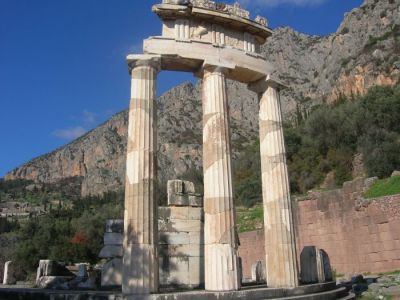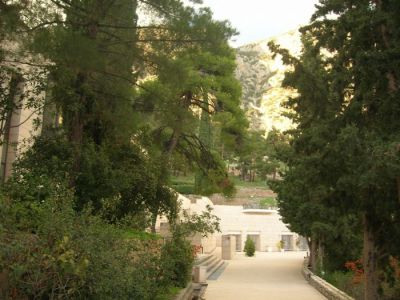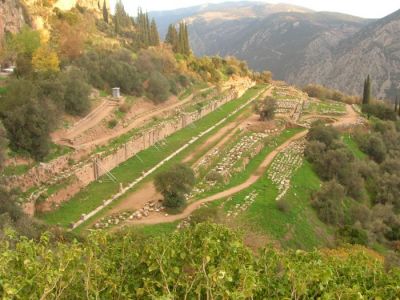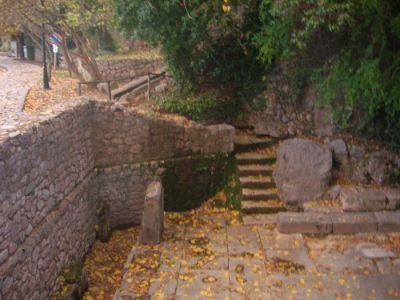| Delphi, The temple of Apollo

The Sacred Way runs along the protective wall of the platform
of the Temple of Apollo, which in the ancient times covered an
Ionic row of columns made of Parian marble, financed by the
Athenians after the Persian wars had ended. It is a petipteral
temple of Doric order, 60.32 x 23.82 meters, with poros stone
pillars plated with marblestone, 6 on the small sides and 15
on the large ones. The cella had two pillars, both on the
porch as well as on the opisthodrome, whereas inside there was
the adyton, the most sacred of all spaces that no one could
enter, since it contained the omphalos, the centre of the
world. The pillars architraves were adorned with the shields
of Persians from the battle at Plataeae and of the Gauls of
the third century BC.
The roof was covered with marble tiles.
It is believed that there was an underground space where only
the pythian soothsayer could enter, in order to obtain the
oracles from the gods. The side of the platform close to the
mountain, on the temple's right side, suffered serious
landslides. During one of them, probably in 373 BC, the bronze
chariot dedicated in 474 BC by the tyrant of Syracuse
Polyzalos was buried. The statue of the Charioteer, in natural
dimensions, is one of the most famous masterpieces of archaic
art and was brought to light during excavations; today, it
adorns the Delphi Museum.

The Theatre.
A small scale connected this platform with the theatre, which
was built in the fourth century BC and was restored during the
Hellenistic and the Roman period. A terrace wall called
Ischegaon from the verb ischo which means "to retain the
earth" supported the cavea on the hillside. The cavea
consisted of 35 rows of seats and had a capacity of 5000
spectators. One can still see the cobblestone orchestra and
the foundations of the stage, adorned with a marble frieze
depicting the Labours of Hercules, today kept in the Museum.
Above the sacred yard a clear path leads to a small valley
where the stadium is. A part of it was built during the fifth
century BC, but it was subsequently restored several times. On
the north side, towards the mountain, there are 12 rows of
columns carved in the rock. On the opposite side, another 6
rows stand upon earlier foundations. In this stadium there
took place every four years the Pythian Games, which included
musical and theatrical competitions, held at the theatre, as
well as chariot races, held at the valley. In 528, right after
the sacred war, the Pythian Games were reorganized with a new
set of rules. Thereafter, they took place more often and went
on until the end of antiquity.
During the Mycenaean period, the female deity of Earth was worshipped in the small settlement of Delphi.
The development of the sanctuary and oracle though, began in the 8th century B.C. with the establishment of the cult of Apollo.
Under the protection and administration of the Amphictyony, the sanctuary continued to be autonomous after the First Sacred War and, as a result, increased its Panhellenic religious and political influence.
The Pythian Games were re-organized, the sanctuary was enlarged and it was enriched with nice buildings, statues, and other offerings. In the 3rd century B.C. it came under the domination of the Aetolians and later, in 191 B.C., was conquered by the Romans.
During the Roman occupation the site was sometimes plundered but was also favored by some of the emperors.
With the spread of Christianity, the sanctuary lost its religious meaning and was permanently closed down with a decree of emperor Theodosius the Great.
The ruins of Delphi were uncovered by the systematic excavations of the French
Archaeological School, which began in 1893.
The village of Kastri, which had occupied the area of the sanctuary since medieval times, was moved to its present position. After the removal of huge quantities of earth that had been accumulated with the landslides, the remains of two sanctuaries, dedicated to Apollo and Athena Pronaea, were finally uncovered.
The excavations revealed more than five thousands inscriptions of all kinds, statues, several miniature objects, architectural decorative pieces, all exquisite works of art, representing the major cities of Greek antiquity.

Outside the area of the Sanctuary, the Stadium, the Gymnasium, the settlement of Delphi and its cemeteries have also been excavated. The only monument that could be fully reconstructed from its own building material was the Treasury of the Athenians, which was restored in 1903-1906 by the French excavators, at the expense of the Municipality of Athens.
In 1959, the restoration of the altar of the Chians was completed by the Greek Archaeological Service.
The gradual reconstruction of parts of the Tholos and the Apollo Temple since 1938, has resulted in major changes in the overall appearance of the ancient remains; the Tholos has been rebuilt up to the marble sima at the base of the roof, while of the Temple have been restored the north crepis, the north wall, the columns on the east side, and the ramp of the entrance.
The numerous finds from the sanctuary are housed in the Archaeological Museum of Delphi.
Some of the most important monuments of the site are:
The Temple of Apollo. The visible ruins belong to the last temple, dated to the 4th century B.C., which was peripteral, in Doric order. It was erected exactly on the remains of an earlier temple, dated to the 6th century B.C. Inside was the "adyton", the centre of the Delphic oracle and seat of Pythia.
The monument was partly restored during 1938-1941.
The Treasury of the Athenians. Small building in Doric order, with two columns in antis, and rich relief decoration. It was built by the Athenians at the end of the 6th century B.C. in order to house their offerings to Apollo.
After its restoration, in 1903-1906, it is the best preserved building on the site.
The Altar of the Chians. The large altar of the sanctuary, in front of the temple
of Apollo, was paid for and erected by the people of Chios, in the 5th century B.C., according to an inscription cut on the cornice. The monument was made of black marble, except for the base and cornice which were of white marble, resulting in an impressive color contrast. The altar was restored in 1920.
The Stoa of the Athenians. The Stoa, built in the Ionic order, has seven fluted columns, each made from a single stone. According to an inscription cut on the stylobate, it was erected by the Athenians, after 478 B.C., to house the trophies taken in their naval victories over the Persians.
The Theatre of the sanctuary. It was originally built in the 4th century B.C. but the ruins we see today date from the Roman Imperial period. The cavea had 35 rows of stone benches; the foundations of the skene are preserved on the paved orchestra. The theatre was used mostly for the theatrical performances during the great festivals of the sanctuary.
The Stadium was constructed in the 5th century B.C. and was remodeled in the 2nd century A.D. at the expense of Herodes Atticus. Then were added the stone seats and the arched monumental entrance. It was in this Stadium that the Panhellenic Pythian Games took place.

The Castalia spring. The sacred spring of Delphi lies in the ravine of the Phaedriades. The preserved remains of two monumental fountains that received the water from the spring date to the Archaic period and the Roman era.
The later one is cut in the rock and has niches cut high in the cliff, which probably held the offerings to the Nymph Castalia.
The Tholos. Circular building in Doric order, built in ca. 380 B.C. Its function remains unknown but It must have been an important building, judging from the multi-colored stone, the fine workmanship and the high-standard relief decoration. The monument was partly reconstructed in 1938.
The Polygonal wall. Retaining wall, built after the destruction of the old temple of Apollo in 548 B.C., to support the terrace on which the new temple was to be erected. The masonry is polygonal and the curved joints of the stones fit perfectly in place. A large number of inscriptions, mostly manumissions, are carved on the stones of the wall.
The Gymnasium was a complex of buildings used by the youths of Delphi for their education and practice. It was constructed in two levels: on the upper was a Stoa and a free open space used for running practice, and on the lower was the Palaestra, the pool and the baths (thermal).
|